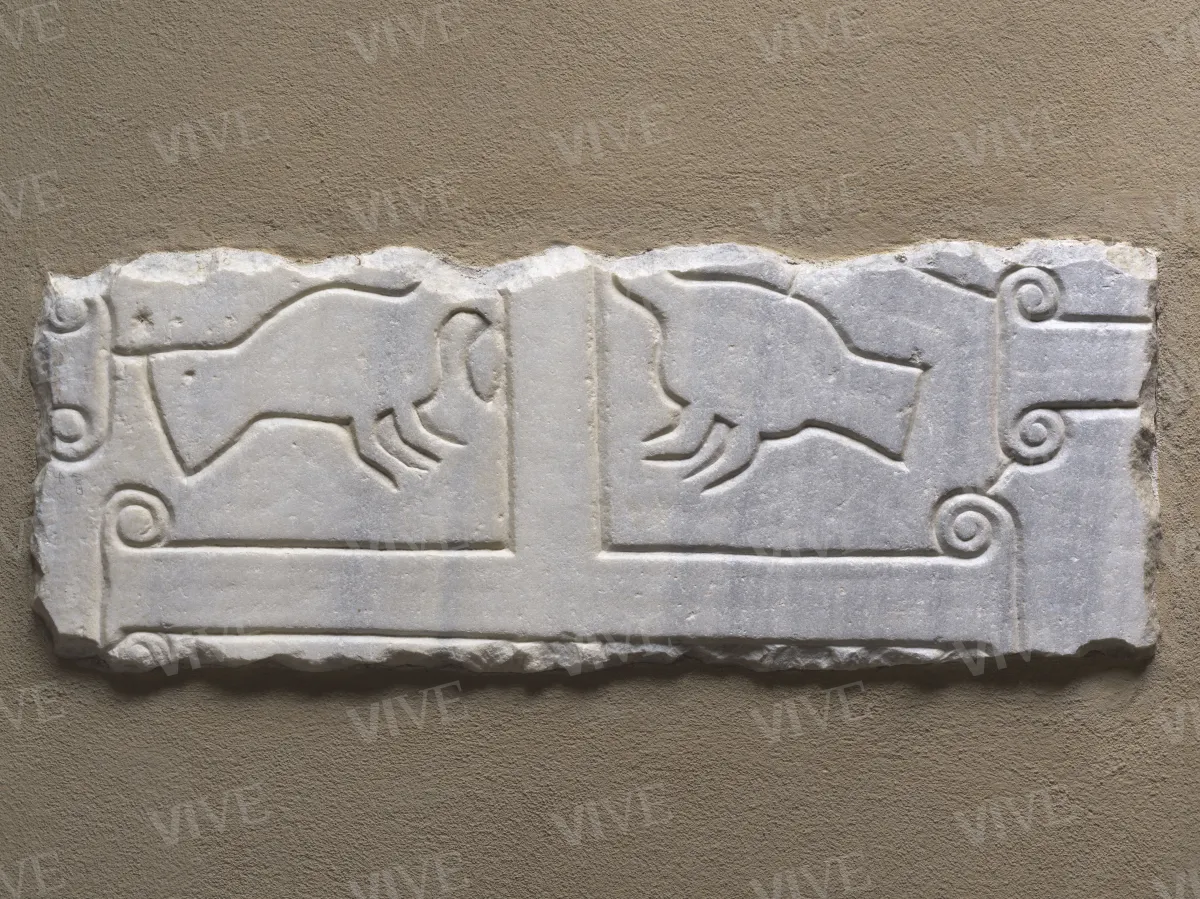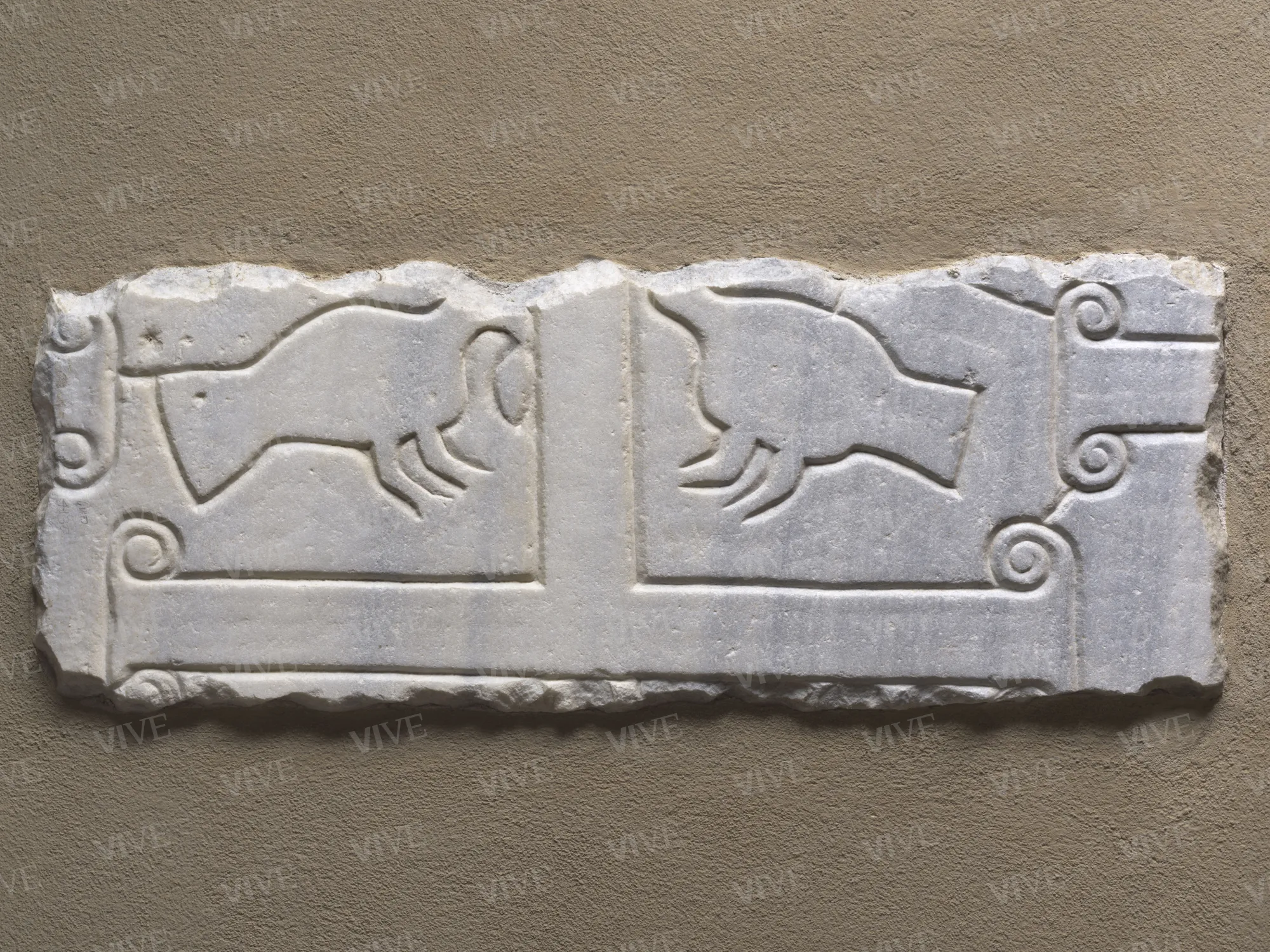Fragment of antependium engraved with crosses and birds facing each other
Roman milieu Late-8th–early-9th century
Fragment of marble antependium engraved with a three-cross ornament with scroll terminations and two facing birds on either side of the central cross, one of which is depicted pecking at a grape.
Fragment of marble antependium engraved with a three-cross ornament with scroll terminations and two facing birds on either side of the central cross, one of which is depicted pecking at a grape.
Details of work
Catalog entry
The marble slab fragment, chiseled and walled into the lower loggia of Palazzo Venezia, is cropped on either side, making it difficult to decipher the overall design of its ornamentation.
A central cross with scroll-like finials, lacking, however, the engravings that would have delineated the lower arm attachment at the bottom, is flanked by two facing birds, probably doves, characterized by accentuated stylization. One of the two is depicted pecking an ovoid form, most probably a grape, an element that introduces the early Christian motif of nourishment, a promise of salvation through Christ's sacrifice (Mazzei 2000). Two other lateral crosses are identified to the right and left by short fragments of the horizontal arm, equally volute-like, and are not compositionally aligned with the central cross.
The slab’s decorative theme would lead us to assume that it was originally designed as an altar frontal: animals facing each other on either side of the cross, a kantharos, or the tree of life constitute a well-known iconographic subject in early Christian and Ravenna sculptural production (see especially the sarcophagus of Ecclesius, basilica of San Vitale), which crop up again in the engraving techniques between the sixth and seventh centuries in the Lombard and Merovingian domains. Lombard works include a slab from San Vincenzo in Galliano, engraved with doves and chrismon inscribed within a circle (Casartelli Novelli 1978, fig. 1), and the pluteus with animals facing each other on either side of the cross from the chapel of San Giovanni Battista in Monza (Lomartire 2009, fig. 37, and Lomartire 2017); Merovingian artifacts, on the other hand, include sarcophagus slabs at Charenton du Cher and Vienne (Hubert, Porcher, Volbach 1968, figs. 25 and 31).
Almost identical traits to those in the design of the bird's tail and legs can be traced to the sixth–seventh century fragmentary slab from Theodoric's villa near Galeata, with its engraving of a peacock flanking a cross (Porta 2015, fig. 3), which can also be traced back—technically and formally—to the Lombard production mentioned above. Moreover, it is precisely in seventh-century Greater Lombardy that we have our terminus post quem for the birth of the "flowered cross" (that is, a cross characterized by volute terminations) present in our fragment, which, starting from the tomb slab of presbiter Guridis da Santa Croce di Savigliano, whose abstract curls form the sign and symbol of the tree of life (Casartelli Novelli 1983, Lomartire 2009).
In Rome, the seventh century was the great "moment" for engraved sculpture (Russo 1984), even though this continues up to the last quarter of the eighth century in Santa Maria in Cosmedin (Macchiarella 1976; Paroli 2001). From the seventh century is the carved antependium with two peacocks drinking at a kantharos, flanked on each side by volute crosses from San Giorgio al Velabro (Mazzanti 1896, fig. on p. 56) and thought to have been created for the restoration of the church by Pope Leo II (682–683). It is, however, in the Tuscany–Latium area that we find our closest relative. A slab from the abbey of Santi Severo e Martirio is held in the Museo dell'Opera in Orvieto (Scortecci 2003, fig. 84–84a). This slab is an original antependium with engraved decorative motifs dated to a period between the eighth and ninth centuries, from a Lombardy church dedicated to Saint Sylvester then repurposed, whose verso was reworked with an ornate mesh. The side engraved with four peacocks facing each other on either side of a volute cross and a kantharos is unfinished, and only contains figure outlines without any definition, similar to the Porto well head, now in the Museo delle Civiltà in Rome (Melucco Vaccaro, Paroli 1995, fig. 120a).
As for our fragment, the absence of information regarding its context of origin and its highly fragmentary state means that we cannot attribute it to any more certain a date.
Valentina Brancone
Entry published on 12 February 2025
State of conservation
Mediocre. Cropped, with chipped edges.
Restorations and analyses
1999 (cleaning).
Provenance
Unknown. Found during excavations around the Palazzetto, as part of demolition carried out in the area for the relocation of the Palazzetto di Venezia (1910–1914).
Sources and documents
Rome, Archivio del Museo del Palazzo di Venezia, inventorying the sculptures of the lower and upper loggias (manuscript inventory edited by Maria Vittoria Brugnoli, 1973).
References
Mazzanti Federico, La scultura ornamentale romana nei bassi tempi,in «Archivio Storico dell’Arte», s. II, II, 1896, pp. 33-57, 161-187;
Hubert Jean, Porcher Jean, Volbach Wolfgang Fritz, L’Europa delle invasioni barbariche, Milano 1968;
Macchiarella Gianclaudio, Note sulla scultura in marmo a Roma tra VIII e IX secolo, in Istituto di Storia dell’Arte dell’Università di Roma (a cura di), Roma e l’età carolingia. Atti delle giornate di studio (Roma, 3-8 maggio 1976), Roma 1976, pp. 289-299;
Casartelli Novelli Silvana, Note sulla scultura, in Arslan Ermanno (a cura di), I Longobardi e la Lombardia, catalogo della mostra (Milano, Palazzo Reale, ottobre 1978), Milano 1978, pp. 75-84;
Casartelli Novelli Silvana, L’immagine della croce nella scultura longobarda e nell’«entrelacs» carolingio della diocesi di Torino, in Schmid Alfred A. (a cura di), Riforma religiosa e arti nell’epoca carolingia. Atti del XXIV Comité International de l’histoire de l’art (Bologna 1979), I, Bologna 1983, pp. 109-115;
Russo Eugenio, Fasi e nodi della scultura a Roma nel VI e VII secolo, in «Mélanges de l’École française de Rome. Moyen-Age, Temps modernes», 96, 1984, pp. 7-48;
Melucco Vaccaro Alessandra, Paroli Lidia, La Diocesi di Roma, t. VI, Il Museo dell’alto Medioevo, Corpus della scultura altomedievale, VII, Spoleto 1995;
Mazzei Barbara, s.v. Colomba, in Bisconti Fabrizio (a cura di), Temi di iconografia paleocristiana, Città del Vaticano 2000, pp. 153-154;
Paroli Lidia, La scultura a Roma tra il VI e il IX secolo, in Arena Maria Stella, Delogu Paolo, Paroli Linda et al., La Diocesi di Orvieto, Corpus della scultura altomedievale, XVI, Spoleto 2003;
Latini Massimo, Sculture altomedievali inedite del Museo Nazionale del Palazzo di Venezia in Roma, in «Rivista dell’Istituto Nazionale d’Archeologia e Storia dell’Arte», 57, 2003, pp. 113-152;
Lomartire Saverio, Commacini e marmorarii. Temi e tecniche della scultura tra VII e VIII secolo nella Langobardia maior, in I Magistri commacini. Mito e realtà del Medioevo lombardo. Atti del XIX Congresso internazionale di studio sull’alto medioevo (Varese-Como, 23-25 ottobre 2008), I, Spoleto 2009, pp. 151-209;
Porta Paola, Sculture altomedievali dagli scavi della villa di Teoderico a Galeata, in «Ocnus. Quaderni della Scuola di Specializzazione in Beni Archeologici», 23, Bologna 2015, pp. 183-198;
Lomartire Saverio, La scultura nella Langobardia maior, in Brogiolo Gian Pietro, Marazzi Federico, Giostra Caterina (a cura di), Longobardi. Un popolo che cambia la storia, catalogo della mostra (Pavia, Castello Visconteo 1 settembre-15 dicembre 2017), Milano 2017, pp. 302-309.












